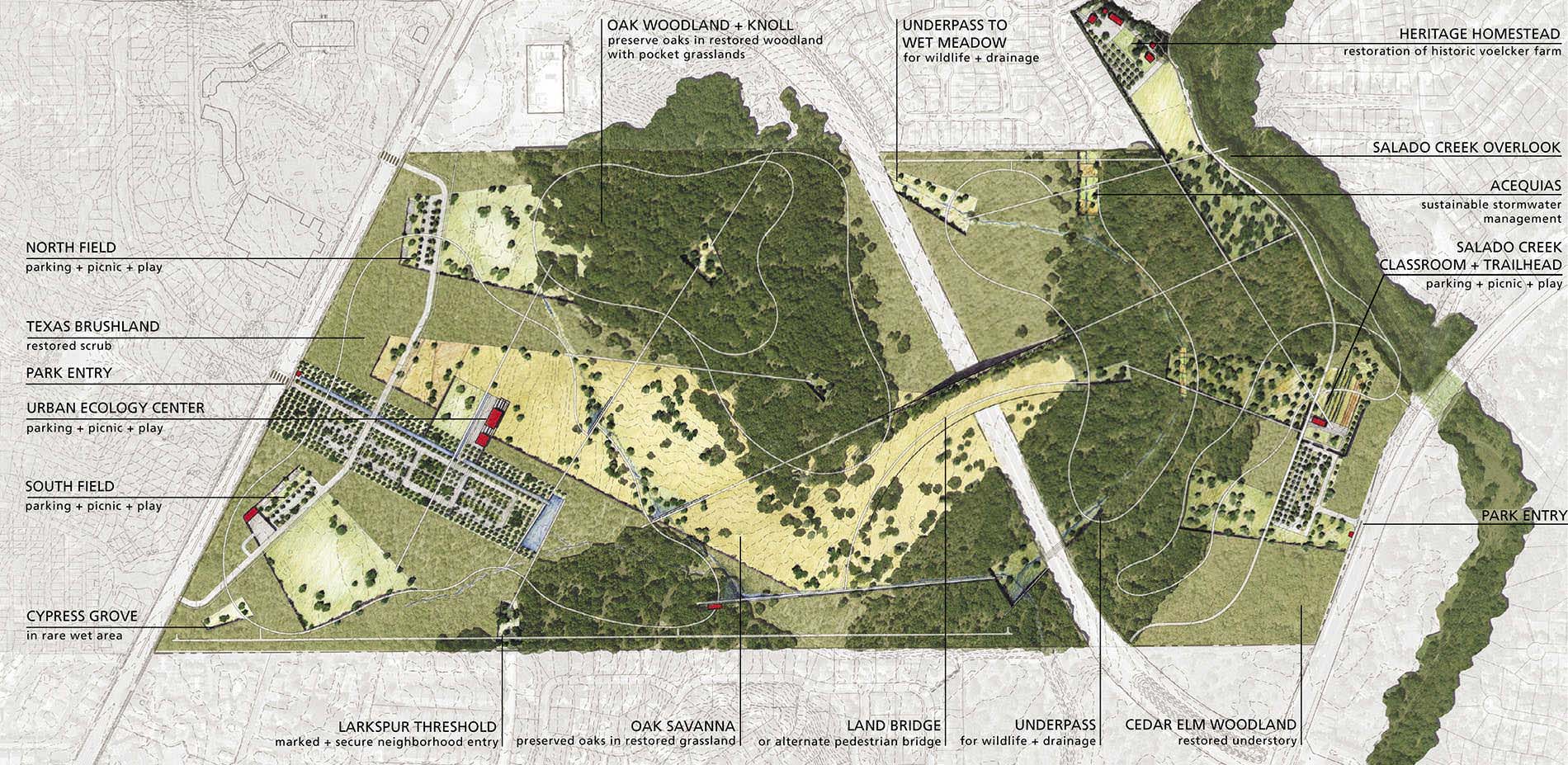
Site Master Plan
Photo Credit: Stephen Stimson Associates
Media: Please submit high-resolution image requests to images@asla.org.
Over eight miles of loop trails are sensitively inserted in restored Oak Savanna, Cedar Elm Woodland, and Texas Scrubland. The site’s hydrology forms the backbone of these varied ecologies, choreographing visitors over seasonal creeks and arroyos.
Photo Credit: Stephen Stimson Associates
Media: Please submit high-resolution image requests to images@asla.org.
Signage is an integral component throughout the three-hundred acre park. The design and scale of the wayfinding signage takes cues from the southwest region of Texas and the Park’s concept as an urban wild.
Photo Credit: Lauren Stimson
Media: Please submit high-resolution image requests to images@asla.org.
The Urban Ecology Center (UEC) is the gateway to the Park. The architecture was conceived as an integrated landscape element, with solar power, water harvesting, stormwater cleansing and environmental education.
Photo Credit: Casey Dunn
Media: Please submit high-resolution image requests to images@asla.org.
The “Grand Acequia” captures, cleansers, and infiltrates stormwater from the UEC’s parking lot. Over 800’ long, this bioswale is planted with native grasses and wildflowers, and edged by limestone gabions.
Photo Credit: Danny Watson
Media: Please submit high-resolution image requests to images@asla.org.
Rainwater is harvested for the irrigation of the UEC’s demonstration pilots. This cycle is displayed in an intimate greywater courtyard, adjacent to the outdoor classrooms and picnic grove.
Photo Credit: Casey Dunn
Media: Please submit high-resolution image requests to images@asla.org.
Stormwater runoff is diverted at South Field into carefully crafted sediment forebays of native limestone. Embedded within stands of preserved scrubland, these elements mitigate flash floods.
Photo Credit: Stephen Stimson
Media: Please submit high-resolution image requests to images@asla.org.
Picnic rooms are carefully inserted into the Cedar Elm woodland adjacent to South Field for gathering and play. These areas provide much needed open space for the residents of the surrounding populated neighborhoods.
Photo Credit: Charles Mayer
Media: Please submit high-resolution image requests to images@asla.org.
Large stands of heritage Queurcus fusiformis are boldly preserved along the Salado Creek Greenway, acting as living reminders to dismount your bicycle through this pedestrian zone.
Photo Credit: Lauren Stimson
Media: Please submit high-resolution image requests to images@asla.org.
Over thirty species of native grasses, perennials and forbs were planted in the Open Oak Savanna test plots, boosting the savanna’s biodiversity and resilience.
Photo Credit: Charles Mayer
Media: Please submit high-resolution image requests to images@asla.org.
Delicate decomposed granite trails weave carefully through scrubland and provide an immersive experience for visitors.
Photo Credit: Lauren Stimson
Media: Please submit high-resolution image requests to images@asla.org.
Water crossing are sited at distinct locations throughout the Park, expanding the trail system into previously unchartered areas, and creating the interactive movement of visitors over sensitive seasonal waterways.
Photo Credit: Charles Mayer
Media: Please submit high-resolution image requests to images@asla.org.
The Salado Creek Overlook cantilevers over a seasonally flooded landscape, allowing for the observation of exposed karst geology, and creek bed wildlife.
Photo Credit: Lauren Stimson
Media: Please submit high-resolution image requests to images@asla.org.
Trails begin and terminate at the Salado Creek Trailhead, a water tank basin station that expresses the collection and retention of water.
Photo Credit: Charles Mayer
Media: Please submit high-resolution image requests to images@asla.org.
Large stands of heritage Queurcus fusiformis are threatened by aggressive successional brushland. Cultivating a City-wide environment ethic, these trees are enhanced and preserved through a series of ‘trail and tree encounters’ that celebrate these ecological communities.
Photo Credit: Lauren Stimson
Media: Please submit high-resolution image requests to images@asla.org.


















